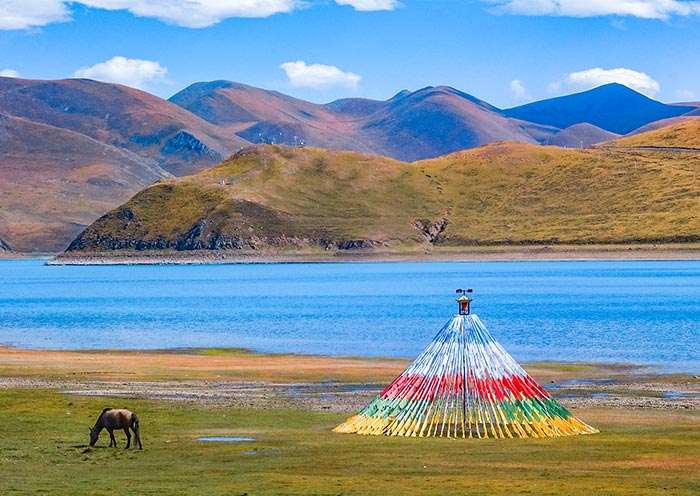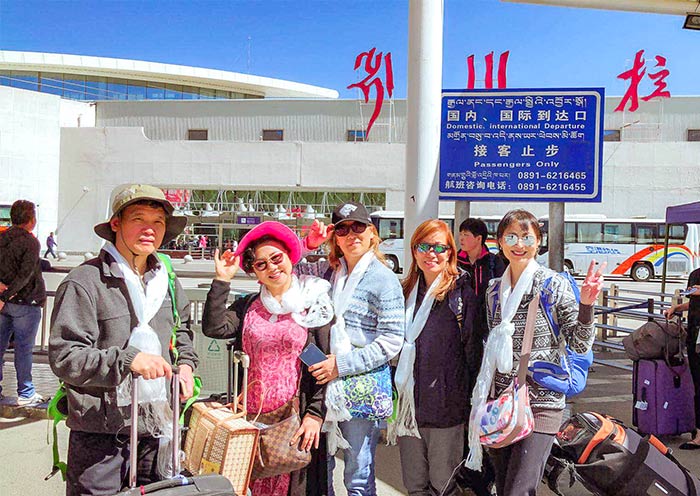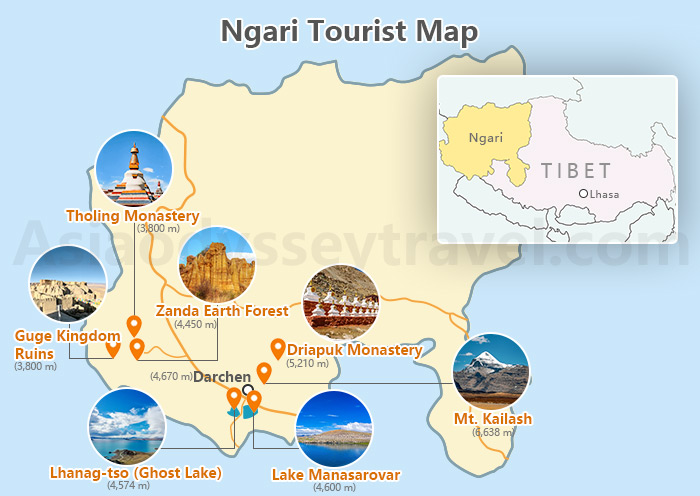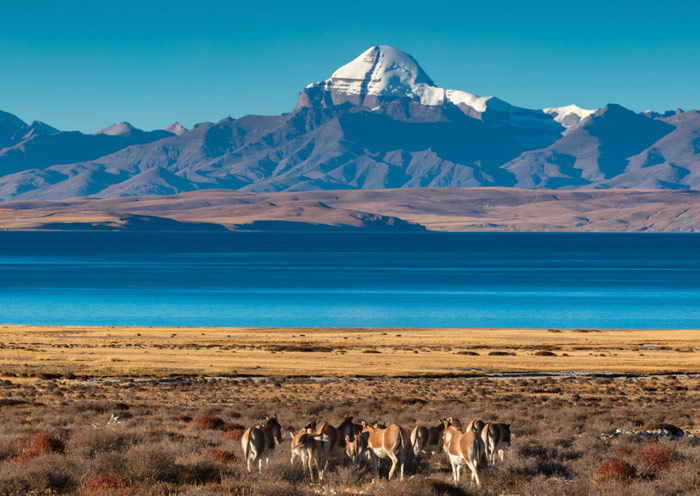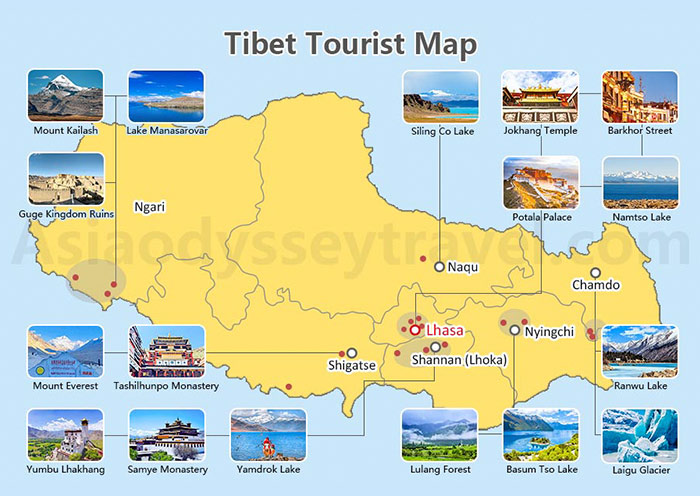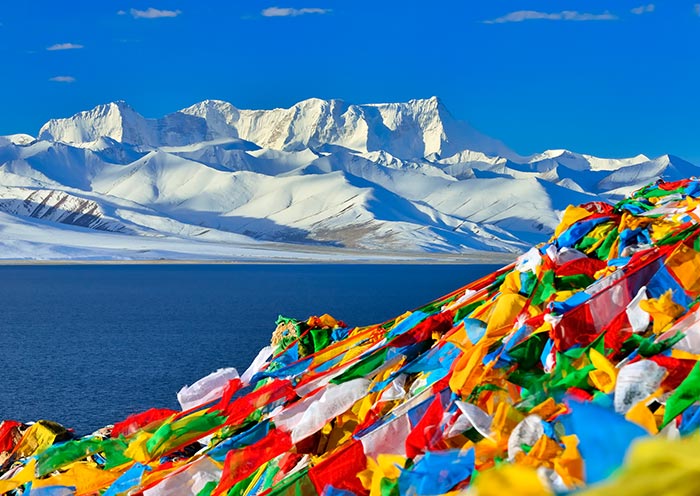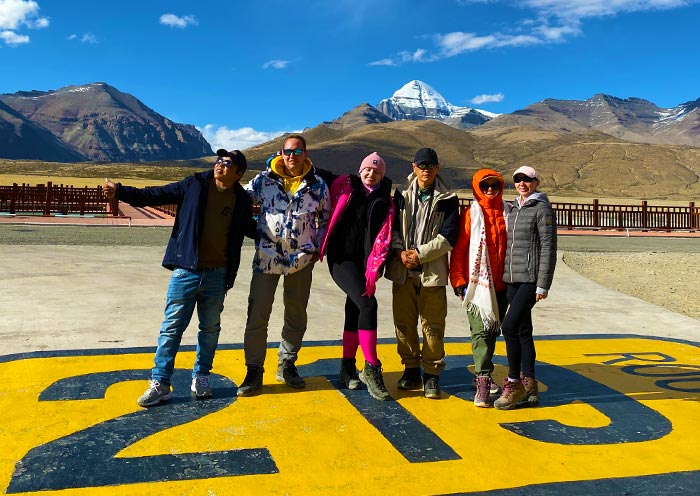Lhasa Jokhang Temple Facts
Chinese Name: Da Zhao Si (大昭寺)
Type: Monasteries & Temples, Religious Sites, UNESCO World Heritage Sites
Altitude: 3,650m (12,000ft)
Best Seasons: All seasons
Open Hours: Monday-Saturday: 12:00pm-18:00pm | Sunday:10:00am-18:00pm
Recommended Visiting Time: 2 Hours
Tickets: 85 Yuan/p.p.
Address: No.2, Barkhor West Street, Chengguan District, Lhasa
What is Jokhang Temple Famous for?
Jokhang Temple is Tibet's most sacred place. Built in the 7th century, it sits right in the heart of Lhasa. Everyone who visits Tibet wants to see it - and here's why!
Jowo Buddha Statue
First, it holds Tibet's most precious treasure: the Jowo Buddha statue. This statue shows Buddha at age 12. Buddhists believe it was made during Buddha's lifetime. People come from all over Tibet just to see it.
Over 1,300 Years Old History
The temple is also special because of its age. It's over 1,300 years old! The building mixes styles from Tibet, Nepal, and China. Every morning, you'll see hundreds of Tibetans walking around it, spinning prayer wheels and praying. This daily ritual is called kora.
Golden Roof Views
The roof gives you amazing views. You can see the Potala Palace and the busy Barkhor Street below. The best time to visit is early morning. That's when you can watch locals burning incense and making offerings. At this time, you'll feel the real spirit of Tibet.
Inside, golden statues and bright paintings fill every room. The air is thick with incense smoke. You can hear monks chanting and pilgrims praying.
Jokhang Temple History
The history of the Jokhang Temple dates back to the 7th century, during the reign of King Songtsen Gampo of Tibet.
According to legend, the king built the temple to house a life-sized statue of Sakyamuni Buddha, which he received as a dowry from Princess Wencheng of the Tang Dynasty in China. The statue was initially housed in the Ramoche Temple, which was also built under the guidance of Princess Wencheng.
In 710 AD, the statue was moved to the Jokhang Temple, which became the spiritual center of the Tibetan empire. Over the centuries, the temple underwent numerous renovations and expansions, becoming a magnificent example of Tibetan religious architecture.
Despite these setbacks, the Jokhang Temple remains a testament to the enduring cultural and spiritual significance of Tibetan Buddhism. The temple's history is intertwined with the history of Tibet, and it continues to draw visitors from all over the world who come to experience its unique energy and cultural heritage.

Jokhang Temple Legends
According to legend, the Jokhang Temple was built on the site of a lake after King Songtsen Gampo promised a princess from Nepal that he would build a Buddhist temple where his ring fell.
The ring fell into the lake, which suddenly turned to gold and revealed a nine-story white pagoda. The king was amazed and decided to build the temple there using soil carried by a thousand white goats. It took three years to complete the temple.
Another legend states that the lake was the heart of a sorceress girl lying on her back, with the Tibetan Plateau being her body. Princess Wencheng suggested filling the lake and building a temple to conquer the devil's heart. She also recommended building twelve small temples in remote areas to control the limbs and joints of the devil.
Interestingly, the word "Lhasa" is derived from the Jokhang Temple. Originally, it was called "Resa" in ancient texts, meaning a place built by goats. However, with the construction of the temple and the influx of pilgrims, the name was changed to "Lhasa," which means "place of the Buddha" in Tibetan language.

What to See at Jokhang Temple
Life-Sized Sitting Sakyamuni Statue
There are only three life-sized Buddha statues of Sakyamuni in the world. Sakyamuni, the founder of Buddhism, drew three statues of himself at different ages before his death.
The statues were made according to his 8-year-old, 12-year-old, and 25-year-old images. Among the three, the gilt bronze statue of Sakyamuni as a 12-year-old prince is considered the most exquisite and noble.
The eight-year-old statue was brought to Tibet by Princess Chizun of Nepal when she married King Songtsen Gampo. It is now in the Jokhang Temple, but was damaged during the Cultural Revolution.
The 12-year-old statue was introduced into China from ancient India and brought to Tibet by Princess Wencheng of the Tang Dynasty. It has been enshrined in the Jokhang Temple ever since.
The 12-year-old statue is the most important relic of the Jokhang Temple, attracting hundreds of thousands of pilgrims to worship. Made of gilded bronze and standing 1.5 meters tall, it depicts the Buddha as a prince wearing a bejeweled crown and luxury clothing.
Believers consider seeing the statue equivalent to seeing the Buddha 2500 years ago, making it a precious historical and cultural treasure.
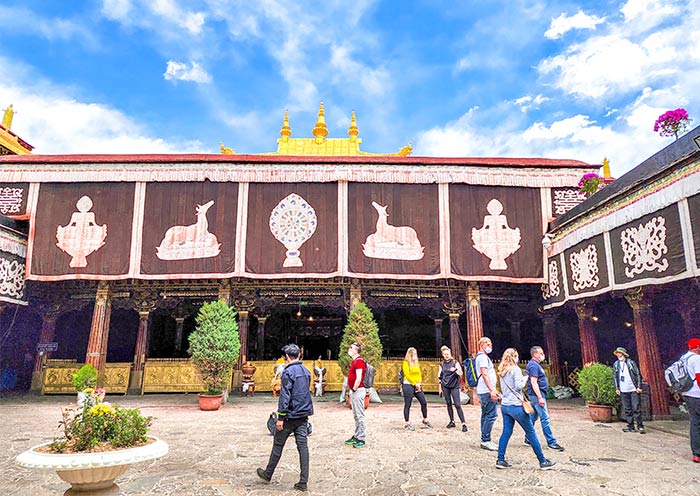
Exquisite Carvings
The Jokhang Temple is renowned for its exquisite carvings, including sandalwood doorframes and wooden pillars dating back to the 7th century. These carvings are unique to the temple and are considered precious treasures due to their rarity and age.
The wood carvings have become as hard as iron over the course of 1,400 years, and produce a metallic sound when knocked. In front of the Sakyamuni Hall, there are eight wooden pillars that have survived since the temple's construction.
In recognition of its cultural and historical significance, the Jokhang Temple was listed as a World Heritage site in 2000. The carvings are a testament to the skill and craftsmanship of the temple's builders and are an important part of the temple's enduring legacy.
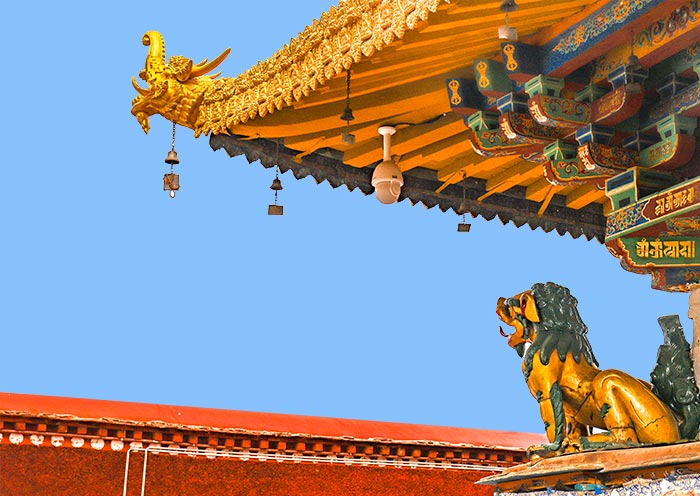
Happy Buddha Statue
The Jokhang Temple is home to a famous Happy Buddha statue, which is believed to have the power to control the weather in Tibet. Every year, before the end of the Tibetan New Year, the statue is moved out of the temple and shown around the Jokhang Temple.
This is a significant event for the Tibetan people and is believed to bring good luck and prosperity to those who witness it.
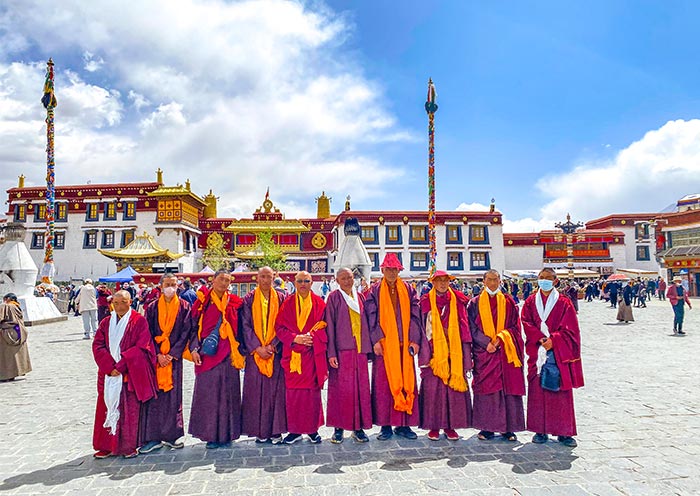
Jokhang Temple Pilgrimage & Circular Routes
Three Circular Routes in Lhasa
The Jokhang Temple is of great importance to Tibetan Buddhism and is a place of pilgrimage for many believers. The temple and its surrounding area have three circular routes, known as Nangkhor, Barkhor, and Lingkhor, which are taken by Tibetan people during their pilgrimage and ritual practices.
The central hall of the Jokhang Temple houses the statue of Sakyamuni Buddha and is surrounded by a circle of rooms known as "Nangkhor," while the outer wall of the temple is surrounded by a circle of rooms known as "Barkhor." The streets radiating from the temple are called "Barkhor Street" or "Eight Corners Street."
The area surrounding the Jokhang Temple, including the Potala Palace, Mount Yaowang, and the Small Jokhang Temple, is known as the "Lingkhor." These three circular routes, from the inside to the outside, are considered the traditional pilgrimage routes for Tibetan people during their ritual practices.
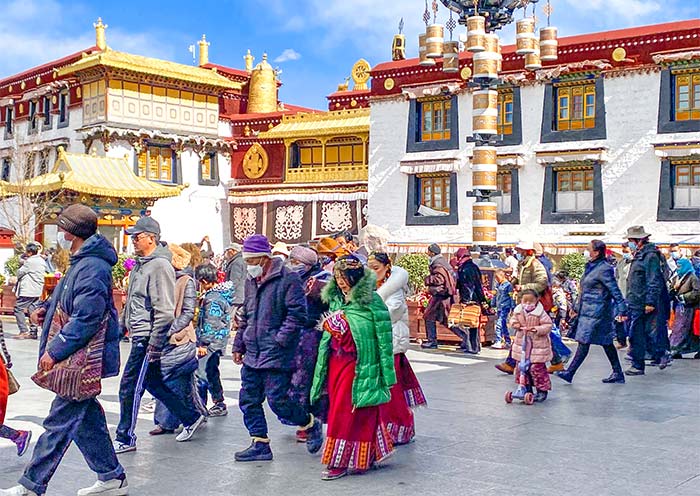
Unique Full-body Bows Scene
The Jokhang Temple is a significant pilgrimage site for Tibetan Buddhists, and travelers to the temple will witness a unique and awe-inspiring sight. As pilgrims arrive at the temple, they face the main door with hands clasped and raised high above their heads.
They then kneel down with their palms on the ground, tap the ground with their forehead, extend their hands straight forward, pause for a moment, and then stand up. This full-body bowing and worshiping is a significant part of their pilgrimage and ritual practices.
Pilgrims can perform this practice for hours, days, or even weeks. When they feel tired, they may take a brief rest before continuing a new round of worship. Visitors to the temple may see hundreds of pilgrims prostrating themselves in the square in front of the temple, bowing and worshiping continuously towards the front gate.
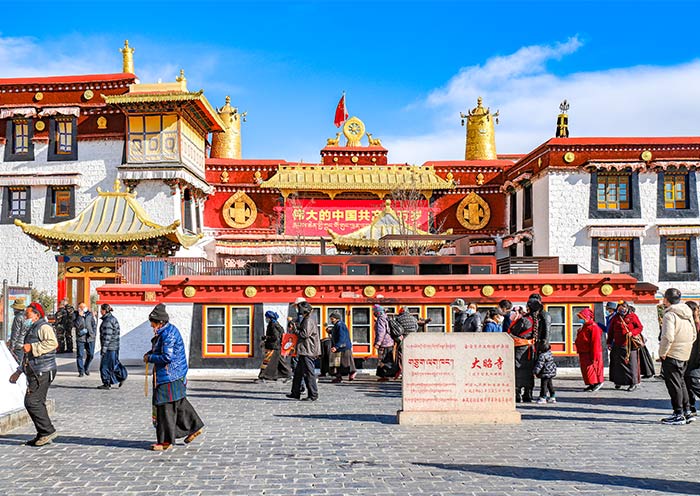
Manners and Taboos of Jokhang Temple
As a sacred place in the Buddhist world, visitors to the Jokhang Temple are expected to behave with respect and good manners. It is important to dress modestly and avoid talking too loud, as it is a place of worship for many individuals.
Smoking is prohibited inside the temple, and visitors should ask for permission before taking photos of monks or pilgrims. It is also important to note that photography is forbidden inside the chapels, out of respect for the religious significance of the temple.
When visiting the Jokhang Temple, it is essential to maintain a respectful attitude towards the temple and its surroundings. By following these manners and taboos, visitors can ensure they are showing their respect for the unique spiritual and cultural significance of the temple.

Jokhang Temple Location & How to Get to Jokhang Temple
The Jokhang Temple is located in the city center of Lhasa, making it easily accessible by bus or taxi. And it can be very easy to walk from your hotel to Jokhang Temple.
Distance from Other Attractions in Lhasa
Distance to Potala Palace: about 2 km, 20-30 minutes by walking
Distance to Sera Monastery: about 7.3 km, about 25 minutes by driving
Distance to Drepung Monastery: about 10.4 km, about 35 minutes by driving
Surrounding Attractions of Jokhang Temple
Potala Palace
The Potala Palace is a world-renowned attraction and an iconic symbol of Tibetan culture and history. Located in Lhasa, the palace stands at an elevation of over 3,700 meters above sea level, making it the highest ancient palace in the world.
The palace is a masterpiece of Tibetan architecture, with its towering white walls and red and gold accents.It is a treasure-house of the best Tibetan artistic works and precious relics, including thangkas, frescoes, statues, and other artifacts that are significant to Tibetan Buddhism.
The Potala Palace was originally built in the 7th century and was the residence of the Dalai Lama until the 14th Dalai Lama fled to India in 1959. Today, it is a UNESCO World Heritage Site and one of the most popular tourist attractions in Tibet.
Learn more about Potala Palace >>

Barkhor Street
Barkhor Street is a must-see destination for travelers to Lhasa, Tibet. Located in the ancient part of the city, Barkhor Street is a hub of traditional Tibetan culture and customs. Visitors will find intact traditional-style streets, paved with stones ground by hand, and lined with colorful prayer flags fluttering in the breeze.
Barkhor is not only a cultural experience but also a market, with almost all houses facing the streets converted into shops. Visitors will find more than a thousand stalls along the street and down the alleyways selling a variety of goods, including butter, barley wine, meat, Tibetan shoes, and knives for daily use.
Additionally, there are religious items such as Thangka, prayer wheels, and prayer flags. Walking along Barkhor Street is an excellent way to experience the unique culture and customs of Tibet, and visitors will be immersed in the sights, sounds, and smells of this bustling market.
Learn more about Barkhor Street >>
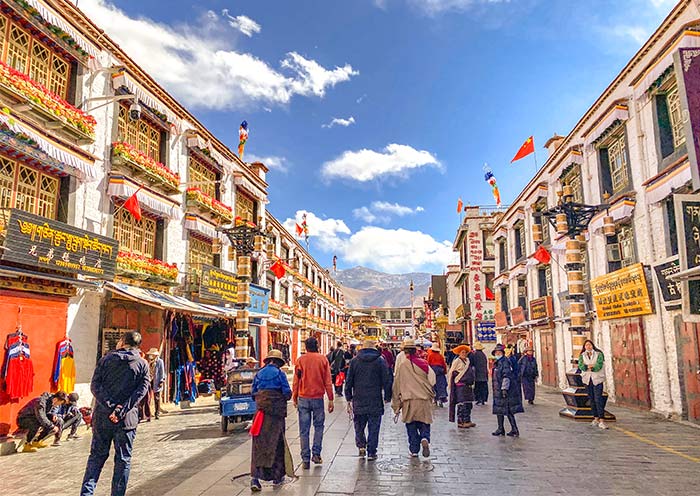
How to Plan Lhasa Tours with Jokhang Temple?
In Tibet, foreign travelers are required to explore with a travel agency. A 4-day Lhasa tour or an 8-day Lhasa Shigatse Mount Everest tour that includes a visit to the Jokhang Temple is a good way to experience the key attractions in the region.
A classic day tour of Lhasa typically includes a visit to the Potala Palace, Jokhang Temple, and Barkhor Street. The Potala Palace, built in the 7th century by the 33rd great king of Tibet, is the symbolic place of Lhasa and is home to the gilded burial stupas of former Dalai Lamas and the meditation Cave of the 33rd great king.
After visiting the Potala Palace, visitors can go to the Jokhang Temple, which was founded at the same time and by the same king as the palace. The temple houses the precious treasure of the statue of Buddha Sakyamuni at the age of 12.
Barkhor Street is a busy walking street in Lhasa where visitors can go shopping for various Tibetan handicrafts and souvenirs. Visitors can also join the Kora with pilgrims and locals to explore Tibetan religious culture more deeply.
Explore Tibet with Asia Odyssey Travel
Local based in Lhasa and Tibet over 10 years, our local team at Asia Odyssey Travel has carefully designed Tibet tours that offer a truly authentic and unforgettable experience. You can choose to travel in the comfort of a private tour with a flexible itinerary, or join a group tour that's budget-friendly without compromising on quality. Whatever your preference, Asia Odyssey Travel has a tour that caters to your needs and desires, ensuring that your journey to Tibet is an unforgettable adventure.

